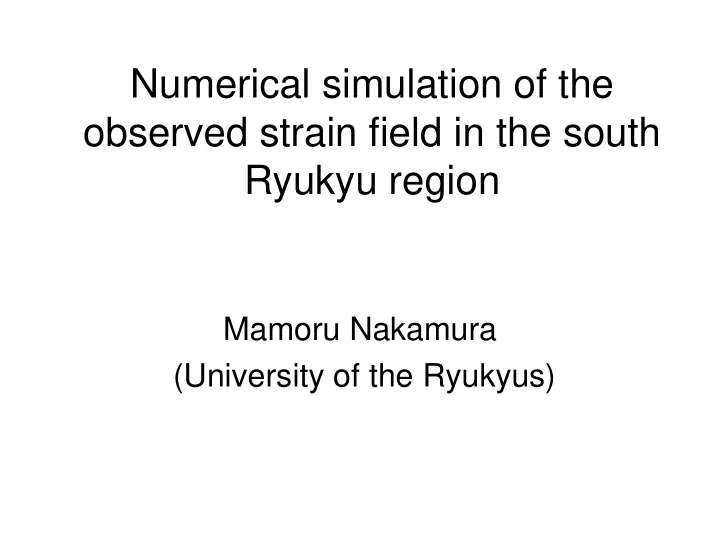

Numerical simulation of the observed strain field in the south Ryukyu region Mamoru Nakamura (University of the Ryukyus)
Subduction- -related driving mechanism of related driving mechanism of Subduction backarc extension backarc extension Corner flow Slab pull Sea anchor Mantovani et al. (2002)
Cross section of subduction zone Cross section of subduction zone Large F SA : extension Reduction in normal force = backarc spreading dF n high F SP Sea anchor force F SA high F SA high dF n backarc spreading Slab pull force F SP Scholz and Campos (1995)
Anomalous S. Ryukyu subduction zone Anomalous S. Ryukyu subduction zone Backarc extension occurs when dFn exceeds a value of 2x10 12 N/m. low dFn and F SA in the S. Ryukyu. Seismic coupling coefficient neutral extensional S.Ryukyu Reduction in normal force Scholz and Campos (1995)
Geodynamic framework around Ryukyu arc Geodynamic framework around Ryukyu arc Eurasian ( Am urian Am urian) ) Eurasian ( Plate Plate Okinaw a Trough Okinaw a Trough Backarc rifting Collision in Taiwan Philippine Sea Plate Philippine Sea Plate
Deformation of subducted plate near Taiwan Deformation of subducted plate near Taiwan
Previous FEM study in the Taiwan- -Ryukyu Ryukyu Previous FEM study in the Taiwan arc area arc area (Hu et al., 1996) (Hu et al., 2001) Trench retreating rate (=slab pull effect) has been set in the initial FEM model apriori. Compute the trench retreating rate!
FEM model (3D shell structure) FEM model (3D shell structure) ) 2 U E ( e t Okinawa Trough(OT) a l p a i s Outer Eurasia plate (EU1) a r u E r e n n I Total node 1973 ) S H P ( e t a l Total elements p a e 1 S 0 807 0 e 0 n m k i p k m p 0 i l 0 i h 0 P 8cm 1
FEM model FEM model 8cm 3D shell structure EU1 PHS EU2 OT friction coefficient 0.0 8cm Young ’ s modulus Poisson ’ s Thickness vertical [GPa] ratio displacement (km) PHS 60 0.25 60 free EU1 30 0.25 15 fix OT 10 0.25 5 fix EU2 40 0.25 40 fix
Results(1) deformation of PHS Results(1) deformation of PHS Depression of PHS: -2 cm/yr Vertical velocity (cm/yr)
Results (2) strain field of EU and PHS Results (2) strain field of EU and PHS
Stress (strain) field in the Okinawa Trough Stress (strain) field in the Okinawa Trough Okinawa Trough: NS extension ( NIED F-net )
Stress (strain) field in the Ryukyu arc Stress (strain) field in the Ryukyu arc Ryukyu arc: Arc-parallel extension ( NIED F-net )
Strain field in the Taiwan Strain field in the Taiwan NS extension EW compression Chang et al. (2003)
Results (3) velocity field in the PHS Results (3) velocity field in the PHS
Results (4) velocity field in the EU Results (4) velocity field in the EU
Observed and computed velocity field Observed and computed velocity field Taiwan: Yu etal.(1997) FEM Ryukyu: GSI ( Shanghai fixed )
Strain (stress) field in the PHS slab Strain (stress) field in the PHS slab
Observed stress tensor in the slab Observed stress tensor in the slab Observed (stress tensor inversion) Computed strain field extension compression
Mechanism from collision to backarc extension Mechanism from collision to backarc extension (1) Collision of PHS to Taiwan (2) Downward bending of PHS ( 1 ) (2) (3) Increase in slab pull force PHS (4)extension (4) Backarc extension (3)Slab pull force
Relation between collision and extension Relation between collision and extension Extension of South Okinawa Trough Extension of South Okinawa Trough Started at 2Ma Started at 2Ma Extension rate has increased at 0.12 Ma Extension rate has increased at 0.12 Ma (Sibuet et al. 1998) (Sibuet et al. 1998) Uplift of Taiwan Uplift of Taiwan Started at 2 Ma Started at 2 Ma Accelerated since 2Ma Accelerated since 2Ma (Lan et al. 1990) (Lan et al. 1990) Collision and extension started at 2Ma.
Collision and backarc extension Collision and backarc extension Mediterranean Aegean Sea Tyrrhenian Balearic SE Asia Ryukyu New Guinea Andaman Mariana Mantovani et al. (2002)
Conclusions Conclusions • PHS-deformation model can explain the strain field in the Taiwan- Ryukyu area. • Direction of the computed velocity does not correspond to the observed one in southwestern Ryukyu area. – Improvement of collision model in Taiwan would be needed. • Collision induces the bending of subducting plate. – Increase in slab pull force and reduce in normal force of plate boundary – Driving mechanism of backarc extension in the collision area
Recommend
More recommend